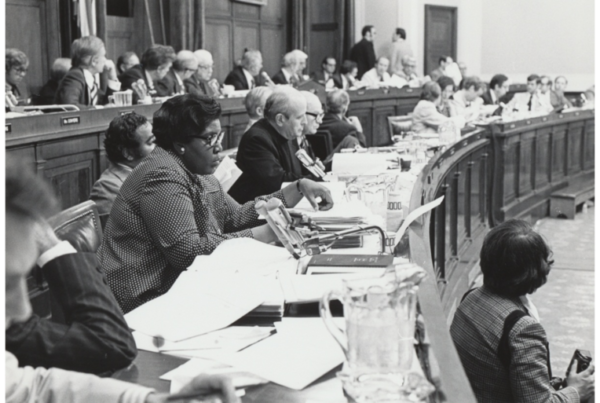On October 2, 1989, the Texas Supreme Court ruled unanimously that the state’s school finance system was unequal. The case was Edgewood ISD versus Kirby, pitting San Antonio’s Edgewood Independent School District against the state education commissioner at the time, William Kirby.
The district argued that since public schools were primarily financed through local property taxes, poorer districts like Edgewood could never raise the kind of money its richer counterparts could. That meant less cash for teacher salaries, supplies, and campus improvements.
It was a question of fairness that had been in the courts for decades before the ruling. Its roots reach back exactly 50 years ago, to a student demonstration at Edgewood High School.
“We knew that, you know, we were smart,” says Rebecca Pena Ortiz, a member of the Edgewood High School class of 1970. “But at the same time if we ever competed in like, UIL contest, when we would go to the other schools for our competitions, we saw what they had. We saw the facilities. We saw their libraries. And we knew that none of that was available to us at Edgewood.”
“At Edgewood we’ve always had a history of people coming and going, coming and going,” she says. “They get their experience, one-two years, and they’re great teachers and then they’re off. They go to a more lucrative district.”
The revolving door and lack of resources directly affected students.
“They were frustrated because they wanted to learn more, and they felt that they were missing out on the opportunity,” says Roger Lloyd, from the class of 1969. “I believe many of them didn’t go, they didn’t go to college because they felt insecure. They felt inferior. I know I did.”
“We had no air conditioning in that school,” says Richard Herrera, who also graduated in 1969. “All the guys carried handkerchiefs. You put them around your neck so you wouldn’t sweat your collar, because we didn’t have a big, large wardrobe. You were going to have to wear that shirt again.”
In 1968, students began to organize.
“Three weeks, maybe a month before, people started going ‘Hey man there’s going to be a walkout, there’s going to be a walkout,’” he says. “We were like ‘What are you talking about?’ The leading up was all the discussion – ‘are you going to do it, are you going to do it, are you?’ ‘Oh no, I can’t. No, I was told not to.’”
The school warned athletes that if they walked out, they wouldn’t be on teams the following year.
“The seniors were told, ‘You will not cross the stage, you will not get a diploma, you will not graduate,’” says Diana Herrera, who graduated in 1969.
“We knew what we were doing and we knew that there might be a price to pay both at school and at home,” says Rebecca Pena Ortiz.
The time for the walkout was set: May 16 at 9:20 a.m.
“I remember the day because I felt kind of uneasy,” Roger Lloyd says. “Something was going on but I couldn’t put my finger on it.”
“The teachers tried to stop us,” says Richard Herrera. “‘You’re not coming through this door! Nobody leaves!’ My teacher stands at the door, Miss Mooney, never forget it. ‘You’re not leaving.’ And I have a brother who’s a lowerclassman. Comes to the door, looks through the door and says ‘C’mon Rich, let’s go.’ And Miss Mooney’s in the way so what he does he starts pushing the door, pushing the door and eventually moves her out of the way, and we just all flowed out. Well over 400 kids.”
Rebecca Pena Ortiz says that’s when the students marched to the main office to speak with Bennie Steinhauser, the superintendent.
“And then a spokesperson comes out and says ‘Mr. Steinhauser isn’t here.’ So we look at each other like ‘now what?’ Richard Herrera says.
“And we just felt that maybe we’re doing something that the rest of the students will benefit from,” Rebecca Pena Ortiz says. “It may not be us. It may not be in our time. But it could happen that every school would have the same kind of facility, every child, no matter what your zip code was, would have the same kind of facility and learning environment in the state of Texas. And of course I know that’s still not true to this day.”
“I felt in my heart that the school system, the decision-makers were going to do everything possible for the goodness of an education of a child,” Diana Herrera says. “And it hit me in the face when I started teaching in Edgewood in ‘74. And Richard and I are buying chalk, and are buying little fans so I could have air oscillate in the classroom. You know, crayons, paper.”
“Everybody knows that it’s not right,” Rebecca Pena Ortiz says. “Everybody knows that it’s not fair. Everybody knows that the system is not equal. So why don’t they quit talking about it and just fix it?”
















